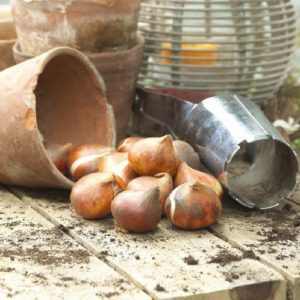Right around this time, as the days begin to cool, everyone here at Eden Brothers begins planning our yearly ritual of selecting, planning, and planting our tulip bulbs. Most days, our warehouse is abuzz with dozens upon dozens of bags bulbs of all varieties being shipped to our customers all over the country. Fairly regularly, a customer will call in with some questions about the proper practices to follow when starting these gorgeous flowers in the fall to ensure a prosperous and colorful bloom come springtime. We’ve complied a list of some of the most commonly asked questions regarding planting tulip bulbs, and provided our best answers to help home gardeners everywhere make the best selections, as well as give their gardens the best change at becoming the envy of the neighborhood come springtime. Check them out below!
FAQs about Tulip Bulbs
Why Do Tulip Bulbs Need to be Planted in the Fall?
Flowers that bloom in the spring, and start from bulb, must be planted once both air and soil temperatures are cooler, ideally once temps begin to stay in the mid-60s. These types of flower bulbs require a fairly long period of cold temperatures to trigger a biochemical process that makes them begin to grow into the tulips we know and love. It’s important to get bulbs into the ground before the soil freezes, so that a strong root system can develop.

Can I Plant a Bag of Bulbs Left Over from Last Year?
It depends. If the bulbs are still firm and plump, they may be able to be planted and product a flower. Since a bulb is actually a living plant, it will really depend on how they’ve been stored over the last year. We wouldn’t recommend only planting older bulbs, so be sure to browse our expansive selection of tulip bulbs to ensure that your springtime bloom lives up to your expectations. If the old bulbs produce flowers as well, consider it an added bonus!
Should I Plant Tulip Bulbs Earlier, or Later, in the Fall?
A definitive answer will depend on your climate zone, but the earlier you can get your bulbs into the ground, the better. If you’re in a lower numbered climate zone where the first frost may arrive before the end of the fall, it’s important to get your bulbs into the ground with ample time for them to develop a root system before the soil freezes. If you live in a climate zone where you do not experience any ground freezes, be sure to pre-chill your tulip bulbs for two to three months before planting.
What Can I Do to the Soil to Help My Tulips Grow?
Tulips will thrive in a sandy, loamy soil that gives the tulip’s root system plenty of room to grow. Before planting your bulbs this fall, amend your garden bed with a mixture of peat moss or sand, which will “lighten” up the soil and help it drain better, preventing the soil from compacting during fall and winter rains, or snow melt.

What Part of My Garden Should I Plant My Tulip Bulbs?
Tulips will grow equally as well in sunny locations as they do in shaded locations but be sure that they’ll be receiving sun for at least a portion of the day. Be sure to take note of the location of any trees that may be overhanging your garden. In the springtime, those bare branches will be filled with leaves, thus limiting the amount of sunlight that the same spot in your garden may have been receiving during the fall.
What Should I Do with Tulips that Have Already Flowered?
If you’re reading this blog and it isn’t early spring, it’s safe to assume that your tulip blooms have already come and gone. Go ahead and “deadhead” those flowers by clipping off the faded bloom, so that the tulip can put all of it’s energy into the next year’s growth. Don’t go hacking away at the remainder of the growth from your tulips, but rather “hide” them by interplanting annuals or perennials around them that will provide cover for the tulips until springtime rolls around again.
What Kind of Spacing Should I Provide Each Tulip Bulb?
The general rule of thumb of tulip bulbs, and really for any spring-flowering bulb that you may plant, is to follow the “rule of 3.” Take a look at the diameter and height of the bulb and be sure to leave three times the diameter of the bulb of space between each one, and place each bulb three times its height down into your garden bed.
How Do I Tell Which Side is “Up” on my Tulip Bulbs?
For the majority of the varieties of tulip bulbs that Eden Brothers carries, the pointy tip of the bulb should be very obvious and should be placed in the ground with this tip facing upwards. For other varieties that may not have as pronounced of a tip, feel the bulb with your fingers to identify a smooth end and a rough end. The rough end is rough because of developing roots and should be planted facing down. Even if you get a few bulbs mixed up and plant them facing the wrong direction, they should still find their way out of the garden bed and begin to reach towards the sun.
